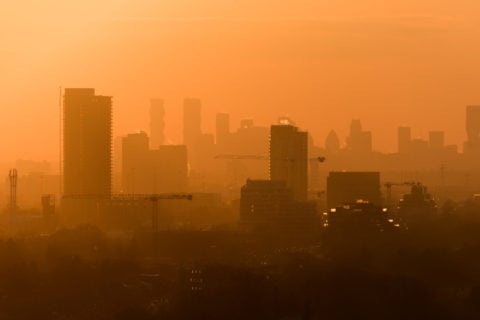How to Protect Yourself This Wildfire Season
From your skincare regimen to clothing choices, here are some small ways to care for your body with pollution permeating the air.
For many of us, wildfires have always felt like a faraway problem — that is, until recently. Last week, sepia skies and smog-filled air blanketed many cities as a result of raging forest fires in Quebec and northeastern Ontario, causing widespread panic and confusion.
RELATED: Feeling Existential Dread Because of Climate Change? Here’s What You Can Do
As clouds of smoke descended onto areas like Toronto, Ottawa and Montreal — and past the border into Washington and New York — even those living far from the fires got a hefty dose of their hazardous effects. Deemed some of Canada’s most severe ever, the wildfires caused air quality alerts to be issued to millions and set off a general sense of foreboding. This, unfortunately, doesn’t seem to be coming to an end. As temps heat up and summer kicks off, experts are forecasting that the 2023 wildfire season could be worse than years past. While it’s hard not to feel anxious about what has been exhaustively referred to as apocalyptic circumstances, it’s increasingly important to know how to care for your body. Presenting: Your guide to navigating a smog-filled summer.
Avoid the effects of smog on the skin
“All this haze and soot and particulate matter damages the skin,” says Dr. Monica Li, a Vancouver-based dermatologist. Excess debris in the air clogs pores, leading to irritation which causes dryness, itchiness, redness, and breakouts. It can also inflame pre-existing conditions like rosacea, psoriasis and eczema. In the long run, smoke can accelerate premature signs of aging. But beyond that, it carries polycyclic aromatic hydrocarbons (PAH), and Dr. Li notes that endured exposure to these components has been linked to skin cancer.
As such, part of protecting yourself means having a consistent skincare routine. Dr. Li recommends implementing an antioxidant into your regimen, like vitamin C serum, which can be applied after cleansing and helps reduce the oxidative stress on the skin caused by environmental aggressors. “You can apply it to the face, neck, chest and the back of the hands where you get the most direct exposure to smoke and poor air quality.” Next, she suggests gently exfoliating twice a week before bed to slough off any build-up. On an everyday basis, both your cleanser and moisturizer should be gentle and ideally fragrance-free, so as to not further irritate the skin. Look for a good moisturizer — with ingredients like lipids and ceramides — that will not only create a barrier but help strengthen the skin’s natural structure. And don’t forget the sunscreen. “People might think that when the smoke is so thick and hazy, UV rays don’t get through. But that’s not true,” says Dr. Li. Irrespective of the fog-shrouded atmosphere, be sure to wear sunscreen with at least 30 SPF and marked “broad spectrum,” meaning it protects against both UVA and UVB rays.
Take extra care of your eyes and hair
Our eyes are extremely delicate, and smoke in the air can damage their mucous membranes, causing a burning sensation, dryness, and even blurry vision. So on days when the quality is bad, don’t neglect them. Dr. Li recommends wraparound sunglasses to give you panoramic protection or simply wearing your prescription specs outside to shield the eyes.
Soot can also settle in your hair, which might cause it to lose its smooth feel and shiny appearance. When particulates coat your scalp, they can cause the skin to be inflamed — for instance, prompting those prone to dandruff to experience worsened reactions. Not to mention, the pollutants that get stuck in your hair can transfer onto your skin, causing breakouts. To prevent this, try wearing a hat and tucking your hair into a bun on hazy days to minimize exposure. And when the air quality is particularly poor, wash your hair before bed, Dr. Li advises. Otherwise, it could rub off on your pillowcase while you sleep and transfer onto the skin.
Consider protection when you get dressed
Last week, experts were recommending masks to people in areas with air pollution warnings, like Toronto. Not only do they offer lung protection — which is particularly important for people with underlying conditions like asthma and heart disease — but they also shield the face. This mindset can be applied to getting dressed.
If you’ve been out during a poor air quality day, Dr. Li advises changing once you come inside. “[Maybe have] a set of outdoor clothes and a set of indoor clothes, so you don’t transfer the debris and dirt back into the house onto sofas, linens, pillowcases, and your own skin,” she says. If you can, she suggests looking into an air purifier to clean up any excess debris in your home. When it comes to outfit selection, it’s also good to opt for fabrics that retain less particulates. Clothes made from natural fibres like cotton and wool are more likely to absorb smoke particles, so, if possible, try steering clear of those when the 2023 wildfire smog is heavy. If the weather permits, protection via long sleeves and pants is ideal. For comfortable coverage during hot summer months, lightweight clothing, like loose-fitting linen, can provide a preventative layer while allowing your skin to breathe.
Moral of the story? “Think of [creating] physical barriers,” says Dr. Li. Whether it’s wearing a hat, sporting sunglasses, using a mask, or moisturizing your skin, these coatings can prevent damage from exposure. “The air quality index can be helpful to guide decisions,” Dr. Li notes, and when the pollution is visibly thick, it’s best to avoid going outside altogether, if you can. Of course, some of these precautions aren’t always possible. The important thing is that we’re aware of them, as we brace for the continued effects of the 2023 wildfire season.









